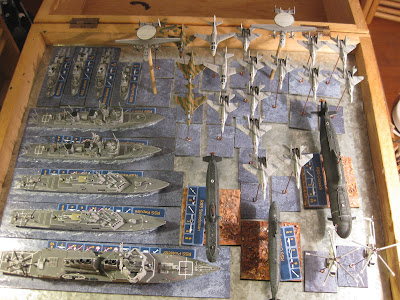 |
| My 1:700 Japanese Fleet |
One of the things I remember from my childhood was playing a game called Seastrike. Seastrike was at its best when you used scenarios. This meant that you had no idea what you opponent was up to, which made asymmetric warfare possible and exciting. I wanted to add this excitement to Modern Naval Battles because the standard 25 point game can get a little dull in the middle. Also, as my friend David Making points out, the Modern Naval Battles fleets are not fairly balanced, and as in real life, asymmetric warfare gives the weaker fleets a chance.
I have come up with a set of six scenarios, intended to be used with Modern Naval Battles.
To make these scenario's work, means the addition of one house rule. That is that all reinforcements purchased after the setup phase of the game (including cards) cost double their reinforcement value. This stops skirmish flotillas growing into full scale battle fleets.
I also recommend playing my hidden vessels rule (published here, but if you are not using these, ignore all references to blips and hidden ships below).
Six Scenarios for Modern Naval Battles
Each player secretly chooses a scenario. Check at the end of each turn to see if a player has won or lost by meeting the conditions of victory or defeat. If more than one player wins or loses in the same turn, then the result is a draw. Regardless of the scenario, a side that has no ships or submarines on the table at any time, immediately looses.
Setup
Each side can sets up ships, aircraft and submarines one at a time. Ships can be placed in any row in the players own half of the table.
1. Skirmish
"Commander probe the enemy fleet and discover their strengths and weaknesses."
Points $12
Victory: Keep at least one ship on table for 6 turns. Blips do not count as ships.
Defeat: losing more than $15 of friendly forces.
2. Symbolic
"Commander, our government demands a political statement. Using the forces at your disposal, sink an enemy vessel worthy of a news story."
Points: $15
Victory: At any time after the end of turn two, sink one of the largest visible ship in the enemy fleet, or any ship larger than 6 hull. Blips do not count as ships. If there are no visible ships, destroy a submarine.
Defeat: Don't loose more than $15 of friendly forces.
3. Convoy
"Commander, our fleet needs to be resupplied. Get that supply ship through at all costs commander."
Points $18
Victory: Keep a single non-combatant supply vessel afloat for 7 turns.
Defeat: Supply vessel sunk
4. Control
"Commander, your orders are to sweep the enemy from the seas."
Points: $20
Victory: Sink all or $20 points or more of enemy shipping or submarines.
Defeat: Losing $20 points of friendly forces.
5. Interdiction
"Commander, patrol this stretch of water and ensure freedom of movement for our forces."
Points $25
Victory: Stop enemy from meeting victory conditions for 8 turns.
Defeat: Enemy meets victory conditions. if the enemy also on an interdiction mission, then if lost more points at the end of the 8th turn.
6. Invasion
"Commander, cover the landing beaches until we can land 18 squads of marines on the enemy coast."
Points $30
Purchase 'non-combatant' assault landing ships for 4 reinforcement points each. A landing beach is positioned on the table's centre line.
Victory: Land 18 squads of infantry on the enemy coast. Each landing ship can land 3 squads in one turn if in the first row (adjacent to the landing beach), 2 if in the second row, and only 1 if in the third row.
 |
| Happy Gaming |
Hey - nice stuff mate.
ReplyDeleteThe sea surface looks suspiciously like linoleum kitchen tiles - I have some as well back in Oz :-)
Yup, linoleum tiles from Bunnings, strong (fairly) light and you can sill anthing on them and wipe them clean
ReplyDeleteScenarios seem like a cool idea. Can you tell us more how you use the ship models for your games ?
ReplyDelete